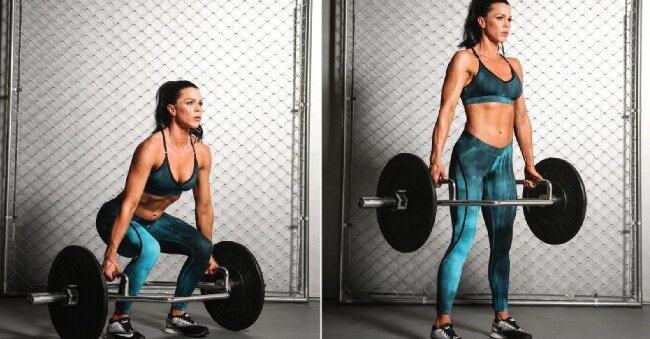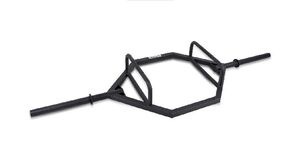
10 Innovative Exercises with Hex Barbells for Full Body Workout
If you’re looking to take your workout routine to the next level, incorporating hex barbells into your exercises can be a game-changer.
Hex barbells offer a unique twist to traditional barbells and come with benefits like increased grip strength, better muscle activation, and versatility in exercises.
In this article, we will explore the top 10 innovative exercises with hex barbells for a full body workout, along with tips on reps, sets, proper form, and safety precautions.
Discover how hex barbells can revolutionize your fitness journey!
What Are Hex Barbells?
Hex Barbells are a type of fitness equipment commonly found in gyms and used for various strength training exercises. They are designed with a hexagonal shape, which prevents them from rolling on the floor during workouts.
This unique design feature not only enhances safety but also allows for easy storage when not in use. The multiple sides of the hex barbell provide different grip options, giving users versatility in their workouts. Hex barbells are particularly popular for deadlifts, as the shape allows for a more natural and comfortable lifting position, reducing strain on the lower back. The even weight distribution of hex barbells makes them ideal for beginners and seasoned lifters alike, offering a stable and balanced workout experience.
How Are Hex Barbells Different From Regular Barbells?
Hex Barbells differ from regular barbells due to their unique hexagonal shape, providing more stability and control during exercises. Unlike traditional straight barbells, hex barbells allow for a more neutral grip, reducing stress on the wrists and shoulders.
The design of hex barbells also enables users to perform movements such as deadlifts with a more natural and comfortable stance, as the weight is centered within the frame of the barbell. This centered positioning can enhance overall power output and reduce the risk of injury.
In contrast, regular barbells are typically longer and require a pronated grip, which may strain the wrists and limit the range of motion for certain exercises. This versatility and ergonomic design make hex barbells a popular choice for individuals looking to improve their strength training routines.
What Are The Benefits Of Using Hex Barbells?
Using hex barbells in your workout routine offers a range of benefits for muscle building and overall fitness. These benefits include increased grip strength, better muscle activation, and greater versatility in exercises.
Incorporating hex barbells can also lead to improved functional strength, as the unique design helps distribute weight more evenly, reducing the strain on joints and minimizing the risk of injury.
Utilizing hex barbells in exercises like deadlifts and squats can target multiple muscle groups simultaneously, optimizing your training efficiency and enhancing overall muscle development.
The balanced nature of hex barbells allows for a more natural movement pattern, leading to better muscle engagement and coordination, ultimately contributing to greater strength gains and progress in your fitness goals.
Increased Grip Strength
One of the key benefits of using hex barbells is the enhancement of grip strength, which is crucial for performing exercises like deadlifts, rows, and farmer’s walks that require a strong hold on the barbell.
Having a strong grip can significantly impact your overall strength training progress. Exercises such as wrist curls, reverse curls, and forearm planks can target the muscles in the hands, wrists, and forearms, thus improving your grip strength.
Incorporating high-rep sets, such as 3 sets of 15-20 reps, with moderate to heavy resistance is an effective way to build endurance and strength in the muscles responsible for grip. Consistent training and progression in grip-specific exercises can lead to better performance in various compound movements and reduce the risk of grip fatigue during intense workouts.
Better Muscle Activation
Hex barbells promote better muscle activation due to their ergonomic design, engaging muscles throughout the body, especially the core stabilizers, to maintain proper form and balance during exercises.
This unique design of hex barbells allows for neutral grip positioning, reducing strain on the wrists and shoulders while encouraging a more natural movement pattern.
By utilizing a hex barbell for exercises like deadlifts and squats, individuals can effectively target their glutes, hamstrings, and quadriceps, all while placing less stress on the lower back.
The increased engagement of core muscles with hex barbells not only enhances strength gains but also contributes to overall stability, making them a valuable tool in functional training programs.
Versatility in Exercises
Hex barbells offer a wide range of exercise options for functional training, allowing individuals to perform squats, lunges, presses, curls, and other movements that target different muscle groups for a comprehensive workout.
From engaging the quadriceps, hamstrings, and glutes through squats and lunges to working the shoulders, chest, and triceps with presses and curls, the versatility of hex barbells shines through in targeting multiple muscle groups. These barbells are not limited to traditional lifts; deadlifts can strengthen the posterior chain, while farmer’s walks challenge grip strength and core stability. By incorporating hex barbells into your routine, you can create a full body workout that enhances strength, stability, and overall functional fitness.
What Are The Top 10 Innovative Exercises With Hex Barbells For full Body Workout?
Discover the top 10 innovative exercises with hex barbells that provide a complete full body workout, targeting various muscle groups and enhancing strength, endurance, and functional fitness.
- One effective exercise using the hex barbell is the hex bar deadlift, which engages the quadriceps, hamstrings, glutes, and lower back, promoting overall lower body strength.
- Another beneficial move is the hex bar farmer’s walk, excellent for building grip strength and working the forearms, shoulders, and core simultaneously.
- The hex bar overhead press is a great way to target the shoulders, triceps, and upper back, enhancing upper body strength.
Including these exercises in your routine can offer a comprehensive full body workout with varied benefits.
How Many Reps And Sets Should Be Done For Each Exercise?
Determining the ideal number of reps and sets for each exercise with hex barbells depends on your fitness goals, current strength levels, and the desired intensity of your workout.
For individuals aiming to build muscle strength and size, a typical recommendation is to perform 3-4 sets of 8-12 repetitions with a weight that challenges your muscles. This range encourages muscle hypertrophy by placing sufficient stress on the muscle fibers while allowing for proper form and technique.
If your goal is muscular endurance, consider increasing the number of reps to 15-20 per set with lighter weights, focusing on maintaining a steady pace to enhance stamina and resist muscle fatigue.
What Is The Proper Form And Technique For Using Hex Barbells?
Maintaining proper form and technique when using hex barbells is essential to prevent injuries, maximize muscle engagement, and ensure effective results from your workouts.
- This involves starting with a neutral spine and a slight bend in the knees, keeping the core engaged throughout the movement.
- Proper alignment of the shoulders and hips is crucial, ensuring they are stacked and in line with each other.
When performing exercises like hex barbell deadlifts, focus on pushing through the heels and maintaining a smooth, controlled motion. Pay attention to the movement patterns, making sure to avoid any jerky or sudden movements that could strain the muscles or lead to injury. By being mindful of your posture and alignment, you can activate the target muscles more efficiently and reduce the risk of common workout-related injuries.
Are There Any Safety Precautions To Keep In Mind While Using Hex Barbells?
When using hex barbells in your workout routine, it is crucial to follow specific safety precautions to prevent injuries and ensure safe and effective training sessions.
- To begin, always make sure that the hex barbell is placed on a stable and even surface before starting your exercises to prevent it from tipping over.
- Double-check the weight plates to ensure they are securely fastened on the barbell to avoid any accidents during lifts.
- It is also essential to maintain proper form and technique throughout your workouts to reduce the risk of strain or overuse injuries.
Remember to listen to your body, start with lighter weights, and gradually increase as you progress to avoid unnecessary strain on your muscles.
Hex Bar Deadlifts
Hex bar deadlifts are a powerful lower body exercise that targets the hamstrings, glutes, and lower back, providing a comprehensive strength training workout for the posterior chain.
To perform a hex bar deadlift, start by standing inside the hexagonal frame of the barbell with feet hip-width apart. Engage the core, keep the back straight, and hinge at the hips while maintaining a neutral spine. Grip the handles on the sides of the bar and push through the heels to lift the weight. This compound movement strengthens not only the muscles mentioned earlier but also enhances grip strength and overall stability. Variations like deficit hex bar deadlifts or paused reps can add intensity and challenge different aspects of lower body strength.
Hex Bar Farmer’s Walk
The hex bar farmer’s walk is an effective exercise for building grip strength, endurance, and overall body stability by walking with weighted hex barbells in each hand.
This exercise is particularly beneficial for individuals looking to improve their grip strength, which is essential for various daily activities and sports. As you walk with the hex barbells, the muscles in your hands, forearms, and shoulders are engaged to maintain a secure grip on the weight, thereby strengthening these areas over time.
Incorporating farmer’s walks into your workout routine can help enhance your overall functional fitness by promoting balance, coordination, and core stability through the engagement of multiple muscle groups simultaneously.
Hex Bar Overhead Press
The hex bar overhead press is a challenging shoulder exercise that enhances upper body strength and stability, targeting the deltoids, triceps, and core muscles for a full-body workout.
By using the hex bar, individuals can achieve a more natural grip positioning, reducing strain on the wrists and shoulders compared to traditional straight bars. This exercise also promotes better posture and engages the core muscles to maintain stability throughout the movement, making it an excellent choice for those looking to strengthen not only their shoulders but also their overall core strength.
Incorporating hex bar overhead presses into your routine can help you achieve a well-rounded upper body workout that enhances both shoulder development and core stability.
Hex Bar Bent Over Rows
Hex bar bent over rows are a great back exercise that strengthens the lats, rhomboids, and trapezius muscles, promoting better posture and overall back health.
By incorporating hex bar bent over rows into your workout routine, you can effectively target key muscle groups in your back. This exercise not only helps in building strength but also enhances muscle endurance and stability in the upper body. Hex bar bent over rows engage multiple muscles simultaneously, leading to a more efficient workout.
Maintaining proper form during this exercise can also aid in preventing injuries and reducing strain on the lower back. Including this compound movement can contribute to a well-rounded back training regimen for improved muscle activation and overall posture.
Hex Bar Lunges
Hex bar lunges are a dynamic leg exercise that targets the quadriceps, hamstrings, and glutes, enhancing lower body strength, stability, and balance.
By performing hex bar lunges, individuals can improve their functional movement patterns, which are essential for everyday activities such as walking, standing, and bending. The unique hexagonal shape of the bar allows for a more natural body positioning during the exercise, reducing stress on the lower back and promoting proper form. Incorporating hex bar lunges into your workout routine can also help increase muscle endurance in the legs and enhance overall athletic performance in activities that require lower body strength and power, such as running and jumping.
Hex Bar Shrugs
Hex bar shrugs are an effective exercise for targeting the trapezius muscles in the upper back and shoulders, enhancing strength and stability in the upper body.
By incorporating hex bar shrugs into your workout routine, you can specifically isolate and engage the trapezius muscles more effectively than traditional shrugs. The hex bar design allows for a more natural grip position, reducing strain on the wrists and elbows while promoting proper shoulder alignment. This exercise also assists in developing shoulder stability, which is crucial for overall upper body strength and injury prevention. Engaging in hex bar shrugs can lead to improved posture and enhanced muscle activation in the upper back and shoulder region.
Hex Bar Squats
Hex bar squats are a variation of traditional squats that engage the quadriceps, glutes, and core muscles, promoting leg strength, balance, and overall lower body power.
The unique design of the hex bar, where the lifter stands inside the barbell, allows for a more upright torso position compared to back squats, reducing stress on the lower back. This upright posture not only helps in maintaining proper form but also enhances core stability.
By distributing the weight evenly, hex bar squats facilitate a more natural and ergonomic movement pattern, reducing the risk of injury and ensuring effective muscle activation. The grip handles on the sides offer better control and balance, making it accessible for individuals of varying fitness levels.
Hex Bar Calf Raises
Hex bar calf raises are an excellent calf-strengthening exercise that targets the gastrocnemius and soleus muscles, enhancing lower leg strength and stability.
This exercise is particularly effective in isolating the calf muscles, as the hex bar allows for a more natural movement pattern compared to traditional calf raises. By maintaining a neutral spine and engaging the core during hex bar calf raises, individuals can also improve their overall posture and balance.
Incorporating this exercise into your routine can help prevent injuries by strengthening the ankles and improving stability. Consistent practice of hex bar calf raises is key to seeing significant improvements in calf muscle development and overall lower leg strength.
Hex Bar Push-Ups
Hex bar push-ups add an extra challenge to traditional push-up movements by incorporating the hex bar for hand placement, targeting the chest, shoulders, and triceps for upper body strength.
The unique design of the hex bar allows for a greater range of motion compared to standard push-ups, enabling deeper muscle engagement in the chest and triceps. This increased muscle activation leads to greater muscle growth and strength gains over time.
The neutral hand position provided by the hex bar reduces strain on the wrists, making it a safer alternative for individuals with wrist issues. Incorporating hex bar push-ups into your routine can also improve your overall pushing strength, helping you progress in other chest exercises like bench press and overhead shoulder press.
10. Hex Bar Bicep Curls
Hex bar bicep curls are an effective arm exercise that isolates the biceps muscles, promoting arm strength and size development for well-rounded upper body training.
One of the key benefits of hex bar bicep curls is that they allow for a more natural grip, reducing strain on the wrists and forearms compared to traditional barbell curls. By engaging the biceps in a different way through the hex bar, individuals can target the muscle from various angles, leading to improved muscle growth and definition. The hex bar also enables a smoother movement pattern, helping to maintain proper form and reduce the risk of injury while maximizing bicep activation. This exercise is particularly beneficial for beginners as it offers a user-friendly introduction to bicep training with its ergonomic design and functionality.




No Comments